
One of the interesting things about collecting vintage Sailor pens is that
I have no idea how many makes and models were ever made. I doubt that the people
at Sailor know either. Most of their records were lost during the war or in fires.
Every time I think I have seen allof the vintage Sailors, I run into something
new. There are no books published in English or in Japanese that list all the
models. Who knows? But it makes collecting these things exciting!
 Sailor is not the oldest Japanese pen maker, but it is the oldest one that continues
to make pens. The Sailor Pen corporation was founded in 1911, nearly a decade
before Pilot/Namiki or Platinum, the other of the big three Japanese pen makers.
1911 was the end of the Meiji period and the beginning of what the Japanese call
the ?aishou Roma_ period. (the romantic years) A time when there were yet no world
wars. The Japanese economy was starting to grow, and the Japanese people were
starting to learn that there was a big world beyond the shores of their island.
England and the US were importing new and exciting products everyday. It was a
great time to be in Japan. Fountain pens that had previously been considered just
a foreign toy, were staring to be accepted as a fashion trend for the young academic
types and the Well-to-do.
Sailor is not the oldest Japanese pen maker, but it is the oldest one that continues
to make pens. The Sailor Pen corporation was founded in 1911, nearly a decade
before Pilot/Namiki or Platinum, the other of the big three Japanese pen makers.
1911 was the end of the Meiji period and the beginning of what the Japanese call
the ?aishou Roma_ period. (the romantic years) A time when there were yet no world
wars. The Japanese economy was starting to grow, and the Japanese people were
starting to learn that there was a big world beyond the shores of their island.
England and the US were importing new and exciting products everyday. It was a
great time to be in Japan. Fountain pens that had previously been considered just
a foreign toy, were staring to be accepted as a fashion trend for the young academic
types and the Well-to-do.
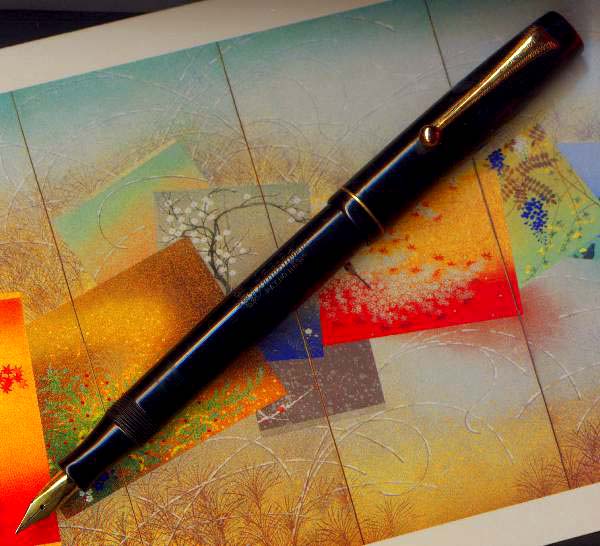
1926 Sailor Pen
The Early Sailor pens were eyedroppers of course. Even though the lever was
well known to the Japanese and the Maruzen Department store had Waterman 58s on
sale, the Japanese pen makers shied away from rubber sacs. There were too hard
to replace in Japan and they tended to rot quickly in the blistering Japanese
summer heat and humidity.
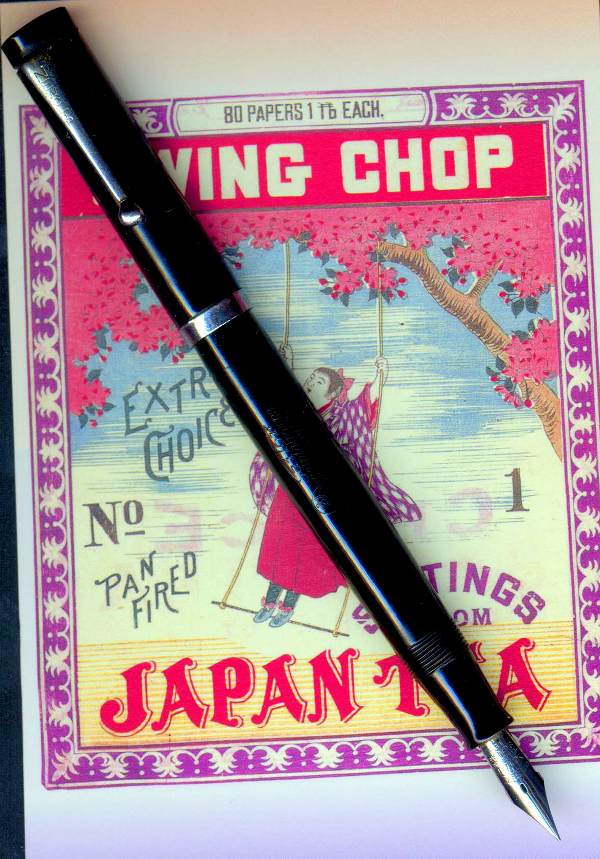
Flat-top
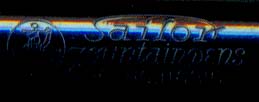 Finding
these eyedroppers today is a little tough. After watching ebay for three years,
I have only seen a few ever listed. Even here in Japan they are not something
that often turns up. But occasionally I get lucky. The prewar pens are usually
flat tops and have the logo with a sailor sitting on an anchor, with the name
Sailor in English. During the war the same logo was used, but the name Sailor
was imprinted using katakana, the Japanese phonetic alphabet that is used to write
English names. I don’t know if that was an act of Japanese patriotism or
not, but it helps to date the pens. After the war, Sailor went back to the English
imprints, and it was then that Sailors started to become very interesting. Finding
these eyedroppers today is a little tough. After watching ebay for three years,
I have only seen a few ever listed. Even here in Japan they are not something
that often turns up. But occasionally I get lucky. The prewar pens are usually
flat tops and have the logo with a sailor sitting on an anchor, with the name
Sailor in English. During the war the same logo was used, but the name Sailor
was imprinted using katakana, the Japanese phonetic alphabet that is used to write
English names. I don’t know if that was an act of Japanese patriotism or
not, but it helps to date the pens. After the war, Sailor went back to the English
imprints, and it was then that Sailors started to become very interesting.
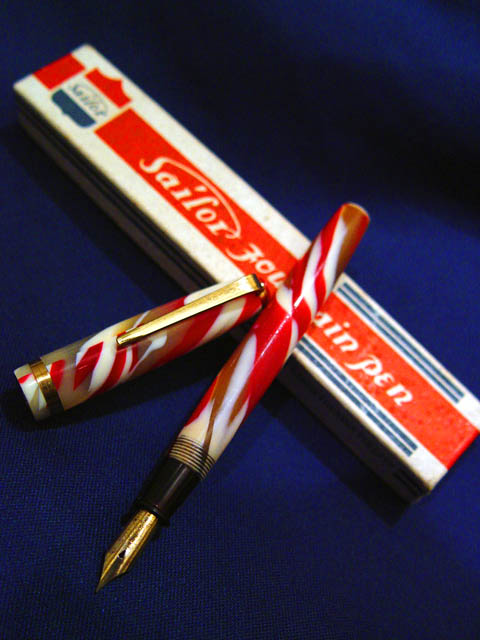
celluloid
You simply can not help but fall in love with the Sailor Celluloid pens. They
are all bright and vivid and you can spot them a mile away. They were produced
between 1948 and 1956, during the reconstruction years. I imagine people found
them cheerful during the harsh postwar depression that plagued Japan. I have seen
about a dozen examples of these pens, but I have never seen two of the same design.
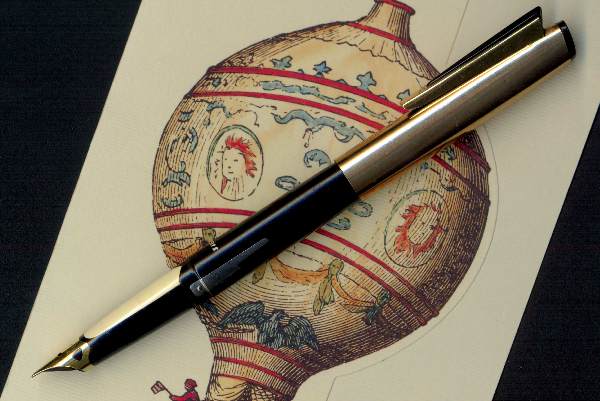
Parley Line
My most favorite Sailor pens are the Parley Line (Sometimes I see this line
referred to as the Paylay line) that was released in 1948. They have a wonderful
Flash Gordon feel to them, and I wouldn’t be the least bit surprised if
the Sailor designers had a model rocket on their table when they made their first
sketches. They are bulb fillers. One interesting thing about these pens is that
the sections are joist fitted. The barrel and the section are shaped in unusual
curves and they fit together like a jigsaw puzzle piece.

Silver
As interesting as these Sailors are to look at, they make fantastic
writers. Today Sailor is known as one of the best nib makers for modern pens.
This simply didn’t just happen. Sailor has always been a leader when it
comes to making smooth, quality nibs.
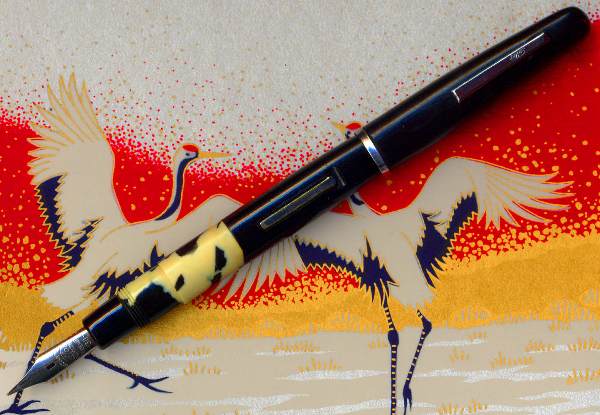
Tsuru
If you have a Vintage Sailor, please contact me. Id love to see your pen.
 Ron
Dutcher has lived in Japan for over 15 years, where he owns and runs a small orthopedic
clinic with his wife, Keiko; which leads him to many Japanese pen finds. His patients,
once they learn of his pen hobby often give him pens as gifts or offer to sell
them to him. He is a member of the Tokyo Pen Association, and has learned a great
deal from Japanese pen collectors. He sells a great many Japanese pens on ebay
under the name Kamakura-Pens, but his true love is for early American pens. He
can be contacted at rd@kamakurapens.com Ron
Dutcher has lived in Japan for over 15 years, where he owns and runs a small orthopedic
clinic with his wife, Keiko; which leads him to many Japanese pen finds. His patients,
once they learn of his pen hobby often give him pens as gifts or offer to sell
them to him. He is a member of the Tokyo Pen Association, and has learned a great
deal from Japanese pen collectors. He sells a great many Japanese pens on ebay
under the name Kamakura-Pens, but his true love is for early American pens. He
can be contacted at rd@kamakurapens.com
|